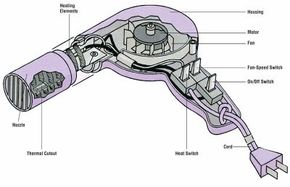How to Repair a Hair Dryer
Hair dryers combine both types of small appliances: those that heat and those that move something. Therefore, a hair dryer includes both a heating element and a fan motor.
Most people don't bother to fix even the simplest problems on their hair dryers because they are generally inexpensive to replace. It's easier to toss them and buy new ones. In the long run, however, it may be more efficient to purchase a better-quality hair dryer and make most of the repairs yourself.
Advertisement
How Hair Dryers Work
Personal hair dryers come in a variety of shapes and sizes, but they all contain the same components and work in the same way. The typical hair dryer includes an on/off switch, a fan-speed switch, a fan and motor, a heat switch, a heating element, and a thermal cutout switch.
The heating switch controls the amount of current delivered to the heating element, thus controlling the heat delivered by the hair dryer. The fan-speed switch controls the speed of the fan motor and fan, thus controlling the force of the air delivered by the hair dryer. The thermal cutout switch, a safety feature, shuts off the heating element if it gets too hot.
How to Repair a Hair Dryer
Common hair dryer repairs include servicing the switch, fan, heating element, and thermal cutout.
Servicing a Switch: On/off, fan-speed, and heat switches all work in the same way. They control the current going to the hair dryer, the fan, or the elements.
Some switches have only two positions: on or off, high or low. Others have three or more. However, they are all tested and replaced in the same way. Here's how to test a hair dryer switch:
Step 1: Unplug the hair dryer and carefully unscrew and remove the housing. Screws are typically recessed near the motor vent.
Step 2: Switches will be mounted in the handle or main housing between the electrical cord and the fan motor and heating element. Remove the switch and disconnect it.
Step 3: Using a continuity tester or multitester, make sure the switch functions as it should. That is, an on/off switch will indicate an open circuit (continuity light off) in the OFF position, and a closed circuit (continuity light on) in the ON position.
Fan-speed switches and heating element switches will show continuity in all settings.
Servicing a Fan: The fan in a hair dryer pulls air in through a vent and pushes it out the nozzle. The fan-speed switch feeds it electrical current.
Hair dryer fans are generally quite durable. The primary causes of problems are hair and
moisture -- two elements found in abundance in a bathroom.
Hair, lint, and other debris can clog up the screen filter on the air intake. To clean it, use compressed air or a soft-bristle toothbrush.

Moisture can damage any motor by shorting out components. To test and repair a hair dryer fan and motor:
Step 1: Remove housing screws and lift off the housing.
Step 2: Remove and inspect the fan blades, repairing or replacing as necessary.
Step 3: Test the motor using a continuity tester to ensure that current has a closed path (continuity light on) through the motor. If not, remove and replace the motor with one of an identical rating in watts and size.
If a replacement motor cannot be found, or if it costs more than half the price of a new hair dryer, consider replacing the entire hair dryer.
Servicing a Heating Element: The heating element in a hair dryer is a continuous high-resistance wire wound around a nonconducting frame. It is installed in the appliance nozzle or output vent. When electrical current is applied to it, the element heats up. The adjacent fan forces air past the element, warming it before it exits the nozzle. To test a hair dryer element if you suspect a problem:
Step 1: Remove the housing of the hair dryer and the element shield.
Step 2: Find the two wires leading to the element. Visually inspect the wires and the element coils for any obvious breaks or debris.
Step 3: Use a continuity tester or multitester to check for continuity. The circuit between the two lead wires should be closed (continuity light on). If not, check the thermal cutout.
Step 4: If the thermal cutout functions properly, replace the heating element with an exact replacement part.
Servicing a Thermal Cutout: A thermal cutout is located in the element assembly of most electrical hair dryers. The purpose of a bimetallic thermostat is to shut the hair dryer element off if it gets too hot. To test the thermal cutout:
Step 1: Open the housing and gain access to the element assembly.
Step 2: Find and inspect the thermal cutout for debris, distortion, or discoloration.
Step 3: Clean the contact points with emery paper. Loosen debris with a few short blasts of compressed air held at sufficient distance to avoid damage to the sensitive element wires.
So, before you toss out that malfunctioning hair dryer, toaster, or other small appliance, make sure the problem isn't an easy one to fix. The tips in this article will help you get those household necessities up and running again.
©Publications International, Ltd.
